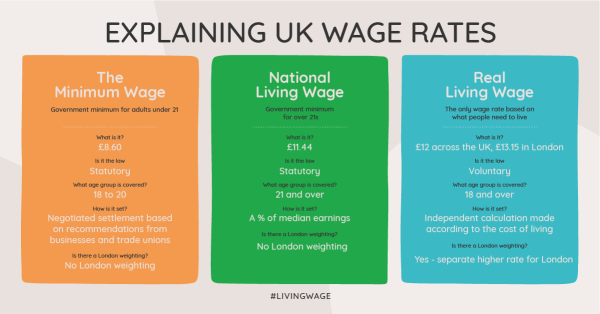
Today (April 1st 2024) the Government's National Living Wage, the legal minimum for workers over 21 and over, increases to £11.44. This still falls short of the voluntary real Living Wage, the only wage rate calculated based on the cost of living, which is currently £12 for workers in the UK and a higher rate of £13.15 in London.
The difference equates to over £1000 (£1,092) per year short of a real Living Wage. The difference could pay for 18 weeks of food for a household, or 12 weeks of housing and energy costs.
Workers in London paid the National Living Wage would need well over £3,000 (£3,334.50) extra to bring earnings in line with the London Living Wage. The difference could pay for almost a year’s worth (49 weeks) of food, or 23 weeks of housing and energy costs.
This year, for the first time, the National Living Wage applies for all workers 21 and over, as opposed to 23 and over. But this means that 18–20-year-olds, many of whom are living away from home and working full-time, are still at risk of being paid just £8.60 per hour. The real Living Wage, set by the Living Wage Foundation, applies to all workers 18 and over.
Katherine Chapman, Director of the Living Wage Foundation said: "The rise in the statutory National Living Wage from 1st April is welcome news for the 3.7 million low paid workers across the country, but this still falls short of a wage which takes into account the real cost of living.
The voluntary real Living Wage is £12 an hour (£13.15 for workers in London) and allows people in the UK to live a decent standard of life. Over 14,000 employers across the UK are Living Wage accredited and committed to going above the government minimum to ensure their staff are always paid in line with the cost of living.
Over the last few years of tough economic times, it has been heartening to see so many more businesses join the movement. As well as good for workers and their families, business that pay the real Living Wage report improved staff retention and productivity. We encourage other organisations who can, to make the Living Wage commitment too.”
Summer, 19, works at Newington Fish Bar in Kent which is an accredited Living Wage Employer, meaning Summer receives the real Living Wage of £12 per hour. Her previous job in hospitality, paid less than the real Living Wage. As a 19-year-old, Summer would be at risk of being paid the minimum wage – just £8.60 - if she worked elsewhere.
“Last summer I spent 7 days a week on low pay trying to pay my bills, leaving me unable to buy many essentials throughout the month. Being in a job that pays the real Living Wage makes me feel like a valued member of the team.
I pay rent and bills plus I am also studying, so being paid fairly is really important. My wages also go towards equipment for my college course and I’m saving to go to university. I don’t have any more time to take on extra hours, due to my studies, but a lot of my friends are working 5 or 6 shifts a week – while studying – just to be able to get by. Most of them are on minimum wage or earning close to minimum wage and they’re really struggling; some only have 1 day off.
I’m grateful to be in the position I’m in now, but it’s really tough for young people on lower wages. When you’re being paid less than your colleagues you feel really undervalued.”
The real Living Wage is the only rate based on the cost of living. The calculation of the real Living Wage uses a ‘basket of goods’ methodology, taking into consideration everyday costs like the weekly food shop and household bills. Over 14,000 employers are committed to going above the government minimum to pay staff a real Living Wage.
